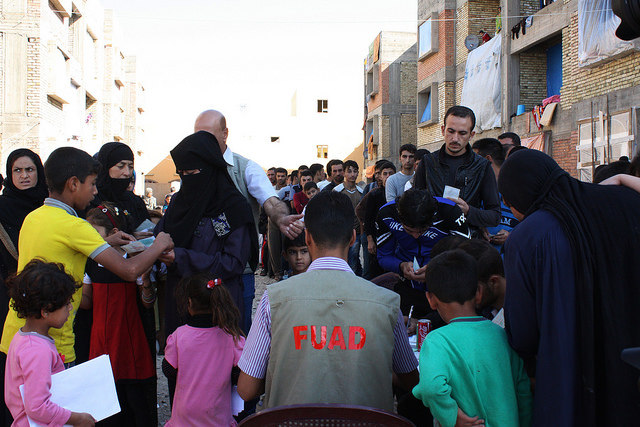A guest post by Steven A. Zyck
In many instances, humanitarian action benefits when it involves local responders who know the situation on the ground and who remember what worked or didn’t during the last crisis.
But this isn’t becoming a reality, as international actors retain a firm grasp over many parts of humanitarian action despite repeated calls for “localisation” in one form or another.
Just look at the numbers. One recent report found that in 2014 donors channelled only 0.2% of their humanitarian assistance directly to local NGOs – down from 0.4% in 2012.
In 2010, USAID committed itself to providing 30% of its overall assistance to local organisations. But from 2010 to 2012, the portion of USAID funding that went to local NGOs increased from 5.7% to 7.5% two years later – a solid achievement but one which fell short of USAID’s appropriately ambitious target.
What does this look like on the ground?
Local Syrian organisations, many run by members of the diaspora, have been largely excluded from donor funding. These organisations are often capable of reaching hard-to-access parts of Syria, but they can’t get nearly the same levels of resources as big international NGOs. Basmeh & Zeitooneh, an organisation established by Syrian refugees in Lebanon, describes being shut out of large grant opportunities despite paradoxically being lauded by donors as particularly innovative and cost effective.

Why is the so-called ‘localisation agenda’ facing such an uphill battle?
To begin with, there are countless linguistic, procedural and practical barriers at play – from English-only coordination meetings to counter-terror legislation to important-but-oft-inflated concerns about corruption and accountability.
Secondly, there are a whole host of financial incentives for UN agencies and international NGOs to continue receiving the majority of international aid. They may, as a principle, support localisation. But agency leaders also fear declining budgets. So some support localisation only where they get to be the middlemen: receiving donor funding, taking their cut and then subcontracting most of the implementation to local NGOs.
What can we do to change this situation and actually make locally-led responses a reality? Here are three basic ideas, many of which are captured in a just-released policy brief published by HPG and the British Red Cross, to push the discussion forward.
First, let’s set some targets for localisation and publicly report on progress against them. Any priority that can’t be measured is unlikely to receive meaningful attention. Donor governments and UN agencies should all be expected to directly – rather than through intermediaries – finance local NGOs in crisis-affected countries.
A small independent secretariat should be established to publicly report on the proportion of funding that different donors and UN agencies give to grassroots organisations. This level of transparent reporting will ideally give way to other initiatives among donors and others, such as sharing good practice for identifying and working with local partners.
Second, we need support in overcoming the practical challenges that often accompany localisation. This includes issues of language and translation, financial reporting and assessing political or factional allegiances among local organisations. The private sector has often dealt with many of these same challenges as it gets to know local suppliers, distributors and cultures across developing and crisis-affected countries. There could be a role for a body such as the World Economic Forum (and its various humanitarian ‘Global Agenda Councils’) in coming up with innovative solutions to some of these practical hurdles.
Third, let’s open a new discussion around capacity-sharing and mutual learning (rather than capacity building). Local NGOs and other on-the-ground actors possess knowledge and skills that their international counterparts could learn from, while international actors have developed systems that local actors require.
Here we’re not just talking about context analysis, needs assessments, financial reporting or monitoring and evaluation – we’re also talking about soft-skills. For example, international actors can learn how to communicate effectively and in a trusted manner in particular situations. Local actors can learn from international NGOs about managing donor relations or negotiating with local authorities or expediting customs processes. Past failures with “capacity building” should not engender pessimism and diminish opportunities for learning.
Lastly, it’s important to avoid promoting homogenisation. There is a real risk that, following the World Humanitarian Summit, a major push to work with local actors will lead many national NGOs and diaspora groups to adopt the same structures, processes and practices as large international NGOs – whether as a result of one-sided “capacity building” initiatives or donor requirements.
Local actors need to maintain their distinctiveness and should be viewed as engines of innovation, with the flexibility to adapt and change, rather than as just another implementing partner to deliver the standard set of aid programmes that international agencies often deliver.
—
Steven A. Zyck is a Research Associate with the Humanitarian Policy Group, Overseas Development Institute. He is the lead author of “Localising humanitarianism: improving effectiveness through inclusive action” and tweets at @SteveZyck.
***
Related Posts
Do we need a network of Southern NGOs to improve humanitarian aid?
Is there a better way for indigenous and international NGOs to work together?
The stories still hard to find: The local responses to Ebola
